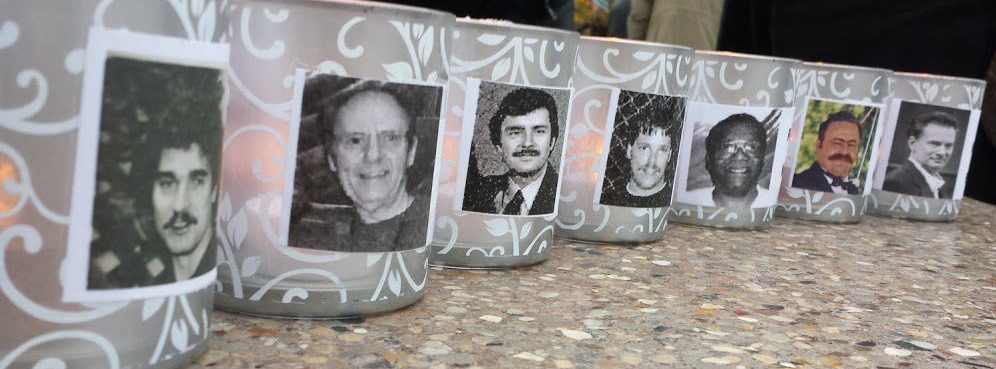“We’re almost there.” I said as I caught sight of the water tower in Stanley, Wisconsin. My husband, Mike, and I were driving West on our way home to Minneapolis from Green Bay. It was Sunday morning of December 27; a few days after Christmas. We were on Highway 29; the stretch of road between Green Bay and Interstate 94, referred to by us freedom fighters as Freedom Highway. We were about to make an important stop. The tower indicated how close we were to our destination; the Stanley prison.

Sign at rear entrance of Stanley Correctional Institution

The prison buildings and Stanley water tower
The white walls of the prison are visible from the highway but during this time of year almost disappear into the wintry landscape. The light blue water tower dwarfs the compound as it stands tall to the east. Dale Basten, the oldest of the six men convicted in the Green Bay Monfils case exists at Stanley. And I do mean…exists.
I always enjoyed correspondence from Dale partly because of how infrequent it was. Although his messages were brief, they were full of genuine warmth and sincerity. I remember Dale was the first to respond when I started writing to all five of the men back in December of 2010. The first card he ever sent was in response to my first Christmas letter to him. It had this simple message:
“Thank you Ma’am for the mail.
It’s the right time of year to get it.”— Dale Basten
Dale is now 74 years old; an aged man who has seen far too many years behind bars for a crime he did not commit. And it is worrisome that I’ve not received a single piece of mail from him in over a year.
Mike and I had more than one discussion about this visit. We both had concerns about the shape Dale might be in because of recent health issues. I was uncertain about how it might go for all of us, especially Dale. I was afraid of what we might encounter. We still looked forward to possibly meeting him as we had Keith Kutska, Michael Hirn, and Reynold Moore earlier in the year. We knew it was going to be emotional but decided to go ahead with the visit. Adding to the anxiety was the status of the case that was slow to change; Dale’s recent parole denial and now the rejection from the judge in granting Keith Kutska a new trial.*
We made it through the usual entry process save for me having to remove my bra while going through the metal detector. Note to myself: Never forgot to wear a sport bra! We finally entered the visitor’s lounge. It was busy as was expected because of the holiday weekend. We were assigned table #18 near the vending machines. It was hard to miss the big signs on the machines that warned against inmate use. We recalled Mike Hirn had been able to handle money and use the ones at Oakhill Correctional. Maybe because that’s a minimum security facility. The inconsistency of rules between prisons confused us. So we simply followed them as best we could.
We sat and waited for Dale, although it was unclear which door he’d be walking through. We chatted as we scanned the room waiting. Before we knew it, an elderly inmate shuffled past our table. He was escorted by a prison guard. They passed us by before we realized it was Dale. We watched as they approached the guard desk where Dale needed to sign in. I stood within view of them and waited. Dale looked confused as he turned to face the lounge. But the guard patiently waited for him to locate his visitors. When they looked in our direction I waved them over to our table. Dale headed toward us only at the urging of the guard that accompanied him.
Dale was thin and frail. His gait was unsteady. I thought he might trip so I braced myself. The guard left us to assist Dale into his designated seat; the one labeled inmate’s seat which faces the guard desk. Dale looked at us and smiled. We introduced ourselves. It was obvious he had no recollection of who we were even though I’d been sending him regular updates and letters for the past five years.
I ignored the obvious and started the conversation. “How are you doing Dale?” I said. He shrugged his shoulders and said, “I’m fine.” He then added that he’d never been in this room before. Mike and I exchanged glances. We were thinking how improbable this was because Dale had been at this prison at least since 2009. We felt fairly certain that his family had visited during that time. We kept our questions simple and asked about everyday life at the prison. Dale’s answers were short. His recollection of current activities was vague. But clarity resurfaced somewhat when we asked him about things of the distant past, like the incident at the mill in 1992.
Dale told us he was a Foreman at the mill. He said he liked his job. He said it was a good one that provided a good life for his family. He told us he did not work in the area of the mill where the incident occurred but that he and Mike Johnson had been called there to help with one of the paper machines. He stated it was during the morning when Tom Monfils went missing. Dale obsessed over his interpretation of how Monfils’ body reacted while in the vat. Numerous times and with his arms, he recreated a swirling, plunging motion as he narrated.
Dale became repetitive as we talked. He couldn’t retain the information we shared about the hearing, the ruling, or more recent related activities. He didn’t recall his parole hearing even though it had taken place only a month prior to this visit. There was no mistaking his love for his daughters despite being able to share few details of their current lives. It was heart breaking. Mike and I had seen these same characteristics in my elderly Mother; the short term memory loss, the vagueness of current events, inability to retain new information, no matter how significant.
We’d brought a Ziploc bag of quarters (no more than $20.00 allowed). In an attempt to lighten the mood, we asked Dale if he wanted something from the vending machine. He said he didn’t like anything sugary. The options were limited so he opted for a can of soda. None of the food choices appealed to him. As we sipped our drinks, I asked if Dale would be up for having his picture taken with us. Dale was okay with the idea so I went to request the necessary form. Mike filled it out and placed it in front of Dale to sign which he needed help with. I returned the form and we were soon called to have two pictures taken.

Mike and Joan Treppa with Dale Basten
We stayed with Dale until visiting hours were over. I was reluctant to leave. I wanted to take care of him as I had done for my own Mother. “This man should be sent home to his family.” I thought. I felt sad for them; his daughters; his former wife, his brother. I thought of their heartbreak. I recalled the letters written by his two daughters that were on the last pages of The Monfils Conspiracy book, only wanting what we all cherish; to be with their Dad in his final years and to live a normal life.
As we got up to leave, Mike discarded the cans on our table. This task was typically up to the prisoner but Dale was uncertain of what to do. The guard came and took his arm and led him to a line forming that would take the prisoners back to their cells. I looked back and waved as we walked through the door to the outside. Dale smiled and waved back.
As I wrote this piece something occurred to me; an underlying issue of a much larger discussion regarding the aging population in the U.S. I was curious about how it affected the prison population. According to sites such as Human Rights Watch, due to the get tough on crime initiative from years ago which caused longer prison sentences for lesser crimes, there are a large number of aging prisoners. This has become a major concern because of the cost and physical care required which has resulted from their elongated incarceration. Although there are plenty of facilities being built to adequately take care of the overall aging population, the problem rests with accepting felons into these facilities.
It’s unclear to me and most likely unclear to immediate families how this transition will happen. What I do know is that time is running out for Dale. It’s running out for a family that still needs him. It’s hard to reconcile this situation and I cannot fathom how this family copes. Seeing Dale that day made me angry at the authorities who will never accept blame for wrongly incarcerating him, at the system that continues to imprison him, and at the parole board for denying him parole knowing full well that this man, even if he had committed this crime, is in no way a danger to society.

Dale Basten with Joan Treppa
I implore whoever has authority over this decision to please send him home!
Updates: On September 5, 2017, Dale was “paroled” due to his failing health and the enormity of costs related to his medical care which amounted to $93,000/yr.
Related news story.
Sadly, on June 23, 2018, Dale passed away. My thoughts as quoted in the following article are as follows: “The passing of Dale Basten is as tragic as the life he was forced to live. I place blame on Brown County and the State of Wisconsin for inadvertently instigating another death as a result of this injustice!” — Joan Treppa
Additional related news story.
Dale’s obituary.
May Dale now rest in peace…
